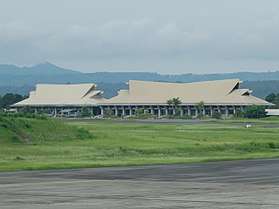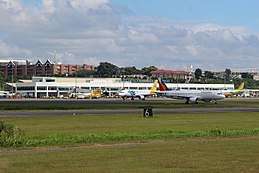Francisco Bangoy International Airport
| Francisco Bangoy International Airport Tugpahanang Pangkalibutan sa Francisco Bangoy Paliparang Pandaigdig ng Francisco Bangoy | |||||||||||
|---|---|---|---|---|---|---|---|---|---|---|---|
|
| |||||||||||
 Airport traffic control tower of Francisco Bangoy International Airport | |||||||||||
| Summary | |||||||||||
| Airport type | Public | ||||||||||
| Operator | Civil Aviation Authority of the Philippines[1] | ||||||||||
| Serves | Davao City | ||||||||||
| Location | Catitipan, Barangay Buhangin, Davao City | ||||||||||
| Hub for | |||||||||||
| Elevation AMSL | 29 m / 96 ft | ||||||||||
| Coordinates | 07°07′31″N 125°38′45″E / 7.12528°N 125.64583°ECoordinates: 07°07′31″N 125°38′45″E / 7.12528°N 125.64583°E | ||||||||||
| Website |
davaoairport | ||||||||||
| Map | |||||||||||
.svg.png) DVO/RPMD Location in the Philippines | |||||||||||
| Runways | |||||||||||
| |||||||||||
| Statistics (2017) | |||||||||||
| |||||||||||
|
Source: Statistics from eFOI[2] | |||||||||||
Francisco Bangoy International Airport (Cebuano: Tugpahanang Pangkalibutan sa Francisco Bangoy, Filipino: Paliparang Pandaigdig ng Francisco Bangoy), also known and still commonly referred to as Davao International Airport (IATA: DVO, ICAO: RPMD), is the main airport serving Davao City and Davao Region in the Philippines. It is the busiest airport on the island of Mindanao and the third busiest in the Philippines. The airport has a single 3,000-meter precision runway.
A new terminal replaces the previous airport terminals, which lie just across it, in handling both domestic and international flights operating to and from Davao. The modern facility is designed to handle approximately 2 million passengers annually and 84,600 metric tons of cargo annually. The added capacity is also complemented by the latest navigational, security, and baggage handling equipment.
The modernization and upgrading of the airport facilities aims to cement Davao as a hub for tourism and foreign investment in the region. Development was funded by a forty million-dollar loan from the Asian Development Bank, co-financed by the European Investment Bank for twenty-five million ECUs, and through budgetary allocations from the government. The total cost of the project amounted to $128 million.
After almost a decade, the new terminal was finally inaugurated on December 2, 2003. Initial construction began in 2000 while plans for construction were announced in 1992.
On November 12, 2007, Cebu Pacific announced this airport as its third hub.[3]
Philippine Airlines, the country's flag carrier, announced this airport as its third hub on March 26, 2018.[4]
History

Francisco Bangoy International Airport began operations in the 1940s with a donation of land in Barangay Sasa, located in the Buhangin district of Davao City, by Don Francisco Bangoy, the patriarch of an influential family who later served as the city's congressman. At the time it began operation, the airport merely consisted of a 1,200-meter unpaved grass runway and quonset huts serving as terminal buildings. At the time, and throughout much of the 1940s and 1950s, both Philippine Airlines and the Philippine Air Force provided air service to the city.[5]

By 1959, the complex consisted of a small control tower and several low-rise buildings. Right of way and access to the terminal buildings and the airport was improved through further donation of land by Paciano Bangoy during the latter stages of his gubernatorial term. A new terminal designed by Filipino architect Leandro Locsin, with a capacity of one million passengers, was constructed in 1980 and the runway was progressively extended from its original length of 1,200 meters to its current 3,000 meters. Both projects were funded during the term of then-Congressman Manuel Garcia, whose congressional district covers the airport perimeter.[5]
Rapid growth at the airport precipitated the construction of a ₱15 million interim international terminal beside the airport's then-existing terminal,[5] and then eventually a new, larger terminal building which would consolidate the two existing terminals. In planning since 1992, construction began in 2000 and subsequently inaugurated on December 2, 2003, with a capacity double that of the old airport terminal. The construction of the new P2.7 billion building was funded by both the Asian Development Bank and the European Investment Bank.[5] The biggest aircraft to land in Francisco Bangoy International Airport is the Antonov An-124 Ruslan (registration number UR-82027), is made to deliver the fuselage of the damaged Cebu Pacific Airbus A320 that overshot the runway during a heavy rain since June 2, 2013.
In June 2015, the Mindanao Development Authority plans to turn the 1980–2003 airport terminal into a trade and cultural museum. The plans are still being studied.
Statistics
Data from Civil Aviation Authority of the Philippines (CAAP).[2]
Passenger movements
| Year | Domestic | International | Total | Change |
|---|---|---|---|---|
| 2003 | 742,436 | 13,185 | 755,621 | |
| 2004 | 1,128,653 | 22,573 | 1,151,226 | |
| 2005 | 1,322,064 | 24,971 | 1,347,035 | |
| 2006 | 1,307,635 | 34,179 | 1,341,814 | |
| 2007 | 1,502,600 | 52,622 | 1,555,222 | |
| 2008 | 1,646,347 | 46,530 | 1,692,877 | |
| 2009 | 1,935,454 | 32,496 | 1,967,950 | |
| 2010 | 2,207,684 | 21,493 | 2,229,177 | |
| 2011 | 2,364,972 | 25,167 | 2,390,139 | |
| 2012 | 2,923,327 | 39,916 | 2,963,243 | |
| 2013 | 2,773,691 | 33,538 | 2,807,229 | |
| 2014 | 3,408,487 | 43,992 | 3,452,479 | |
| 2015 | 4,099,131 | 50,974 | 4,150,105 | |
| 2016 | 3,462,119 | 91,082 | 3,553,201 | |
| 2017 | 4,140,757 | 93,910 | 4,234,667 |
Aircraft movements
| Year | Domestic | International | Total | Change |
|---|---|---|---|---|
| 2003 | 8,968 | 480 | 9,448 | |
| 2004 | 11,366 | 634 | 12,000 | |
| 2005 | 11,968 | 718 | 12,686 | |
| 2006 | 12,920 | 1,034 | 13,954 | |
| 2007 | 13,778 | 1,126 | 14,904 | |
| 2008 | 15,414 | 780 | 16,194 | |
| 2009 | 9,316 | 283 | 9,599 | |
| 2010 | 9,692 | 219 | 9,911 | |
| 2011 | 10,238 | 239 | 10,477 | |
| 2012 | 25,460 | 634 | 26,094 | |
| 2013 | 29,104 | 536 | 29,640 | |
| 2014 | 22,822 | 694 | 23,516 | |
| 2015 | 26,058 | 758 | 26,816 | |
| 2016 | 32,571 | 1,186 | 33,757 | |
| 2017 | 36,094 | 2,399 | 38,493 |
Cargo movements
An em dash (—) is used when data from CAAP is not available.
| Year | Domestic (in kg) | International (in kg) | Total (in kg) | Change |
|---|---|---|---|---|
| 2003 | 30,779,223 | 1,654 | 30,780,877 | |
| 2004 | 41,972,437 | — | 41,972,437 | |
| 2005 | 70,372,167 | — | 70,372,167 | |
| 2006 | 40,753,487 | — | 40,753,487 | |
| 2007 | 45,516,843 | 15,455 | 45,532,298 | |
| 2008 | 53,287,642 | 14,931 | 53,302,573 | |
| 2009 | 34,172,210 | 84,429 | 34,256,639 | |
| 2010 | 40,568,631 | 63,195 | 40,631,826 | |
| 2011 | 34,772,206 | 51,771 | 34,823,977 | |
| 2012 | 42,118,391 | 67,392 | 42,185,783 | |
| 2013 | 44,455,899 | — | 44,455,899 | |
| 2014 | 53,714,155 | 76,347 | 53,790,502 | |
| 2015 | 59,737,244 | 77,062 | 59,814,306 | |
| 2016 | 53,590,101 | 68,400 | 53,658,501 | |
| 2017 | 57,594,657 | 159,342 | 57,753,999 |
Structure
Terminal
.jpg)
The P2.7 billion passenger terminal is a Malay architecture-inspired building which is four times larger than the old terminal. It is fully computerized, more secure and has more commercial spaces for concessionaires at approximately 9,000 sq. meters of gross leasable area. It has four units of jet bridges for passengers. It has also a Flight Information Display System and Closed-circuit television system complementing the terminal's security system.
The terminal has 14 domestic and 14 international check-in counters that can handle a steady flow of passenger traffic. The Check-in counters are equipped with electronic weighing scales and conveyors and its baggage handling system is also computerized. It also has 2 arrival areas, for domestic and international with 2 baggage conveyors each. The Cargo Terminal Building covers almost 5,580 sq. meters and can handle up to 84,600 metric tons of cargo a year.
Runway
The airport has a single 3,000-meter long runway by 45 m wide that can handle wide-bodied aircraft such as the Airbus A330, Airbus A340, Airbus A350, Airbus A380, Boeing 737 Next Generation, Boeing 747, Boeing 757, Boeing 767, Boeing 777, and Boeing 787 Dreamliner. The installation of a new instrument landing system (ILS) for both Runways 05 and 23 upgraded its compliance to International Civil Aviation Organization (ICAO) operating category-Precision Approach Category 1. It can accommodate 8-10 aircraft landings per hour, depending on size and has the equivalent 9 gate holding areas for those aircraft. The airport has also 2 dual access taxiway. Taxiways A3 and A4 are used to access the new ramp and terminal; taxiways B and C are used for access to the old airport ramp.[6]
The largest aircraft to land at the Francisco Bangoy International Airport is an Antonov An-124. The Antonov An-124 is the fourth largest plane in the world, next to the Boeing 747-8.
Other structures
Besides the main terminal building, there are also new support facilities like the Administration Building, Airfield Maintenance Building, Central Plant Building, Hangar for Military and Training aircraft and Fire/Crash/Rescue Building. It has a 688-slot car parking area and 4 slots for shuttle buses. It has a 3-megawatt standby power generator.
Future Development
A Philippine Tourism Development Plan was released by the Department of Tourism, which includes Davao International Airport:[7]
Project 4: Upgrade
This project comprises the following tasks:
- In January 2017, the bidding started for the Rehabilitation and Expansion of Davao International Airport. It includes building a new passenger terminal and a second runway being considered. On May 22, 2017, Sec. Tugade decided that the funds will be from Overseas Development Assistance (ODA).
Airlines and destinations
| Airlines | Destinations |
|---|---|
| AirAsia | Kuala Lumpur–International (ends October 25, 2018)[8] |
| Cathay Dragon | Hong Kong (begins October 28, 2018)[9] |
| Cebu Pacific | Bacolod, Cebu, Clark (begins November 9, 2018),[10] Iloilo, Manila, Singapore, Zamboanga |
| Cebu Pacific operated by Cebgo | Cagayan de Oro, Dumaguete, Tacloban, Tagbilaran[11] |
| Philippine Airlines | Cebu, Clark, Manila |
| Philippine Airlines operated by PAL Express | Cebu, Manila, Siargao[12], Tagbilaran[12], Zamboanga[12] |
| Philippines AirAsia | Cebu, Clark, Manila |
| SilkAir | Singapore |
Incidents
- On April 19, 2000, Air Philippines Flight 541, a Boeing 737-200 en route from Manila to Davao crashed near the airport killing 131 people.[13][14]
- On March 4, 2003, a bomb exploded in the waiting shed outside the old terminal building, killing 21 people. At least 145 others were injured when the bomb went off.[15]
- On the night of August 25, 2008, a Philippine Air Force, C-130 Hercules bound for Iloilo City crashed into Davao Gulf shortly after take off from Davao International Airport. The aircraft sank 800 feet into the gulf. The incident killed nine crew members plus two Philippine Army soldiers.[16][17] After several days of a search-and-retrieval operation, the wreckage was found with the help of a US Navy ship, the USNS John McDonnell.[18]
- On June 2, 2013, a Cebu Pacific Flight 971 (registration number RP-C3266) carrying 165 passengers inbound from Manila, overshot the runway during a heavy rain. There were no fatalities, however the plane was heavily damaged.[19] The damaged aircraft was moved to the old airport terminal for the investigation and parting.
- On October 30, 2015, an engineer traveling back to Manila after a week-long stay was discovered to have possession of two 9mm bullets in his luggage. The engineer posted a bail of P120,000 and reclaimed the bail after charges against him were dismissed and he was allowed to continue to fly back to Manila. Davao officials including the Davao police reiterated that there are no bullet planting schemes in Davao while Rodrigo Duterte, then the city mayor and a presumptive 2016 presidential candidate, theorized that the engineer was victimized by the scheme when the latter was still in Manila and that the bullets were planted by a rouge NAIA personnel at a restricted section of the airport.
See also
References
- ↑ Perez, Ace June Rell S. (2017-05-22). "Davao airport to expand in 2018". SunStar Philippines. SunStar Publishing Inc. Retrieved 2018-06-28.
- 1 2 Civil Aviation Authority of the Philippines (23 July 2018). "Yearly Passenger, Cargo and Aircraft Movements of all airports in the Philippines 1997-2017". Republic of the Philippines - Freedom of Information Portal. Retrieved 13 August 2018.
- ↑ "Cebu Pacific to make Davao its 3rd hub" (Press release). Cebu Pacific. 2007-11-12. Archived from the original on 2007-11-17. Retrieved 2007-11-12.
- ↑ https://businessmirror.com.ph/hk-bangkok-eyed-for-next-foreign-route-of-pals-davao-hub/
- 1 2 3 4 Ajero, Antonio M. (2003-12-01). "Nonoy Garcia, Elias Lopez and other airport tales". Sun.Star Davao. Archived from the original on 2003-12-21. Retrieved 2008-12-14.
- ↑ "Airports – Davao Int'l Airport". CAAP. Archived from the original on 2012-08-29. Retrieved 2012-09-01.
- ↑ "Formulation of the Philippine National Tourism Development Plan 2011–2016" (pdf). Department of Tourism – Philippines. Retrieved 2012-09-01.
- ↑ https://booking.airasia.com/Flight/Select?o1=KUL&d1=DVO&culture=en-GB&dd1=2018-10-25&dd2=2018-10-28&r=true&ADT=1&s=true&mon=true&cc=PHP&c=false
- ↑ "Hong Kong hub strengthens with new Cathay Pacific Group services to Davao City and Medan". 2018-05-30. Retrieved 2018-05-30.
- ↑ https://www.cebupacificair.com/pages/seat-sale-promo
- ↑ Aviation Tribune (2017-09-15). "Cebu Pacific Boosts Davao Hub With Direct Route To Tagbilaran". Aviation Tribune. Retrieved 2018-06-28.
- 1 2 3 "Domestic Schedule" (PDF). Philippine Airlines. 2018-02-06. Archived from the original (PDF) on 2018-02-07. Retrieved 2018-06-28.
- ↑ "Air disaster timeline". BBC. 2007-11-30. Retrieved 2012-07-16.
- ↑ "Accident description". Aviation Safety Network. 2000-05-19. Retrieved 2012-07-16.
- ↑ "Philippines airport bomb kills 18 – March 4, 2013".
- ↑ "Hercules goes down in Davao Gulf; 9 missing". Philippine Daily Inquirer. 2008-08-27. Archived from the original on 2008-10-24. Retrieved 2012-07-16.
- ↑ Ranter, Harro. "ASN Aircraft accident Lockheed L-100-20 Hercules 4593 Barangay Bukana, San Pedro Extension, Davao City". aviation-safety.net. Retrieved May 29, 2017.
- ↑ "US Navy ship to help locate crashed C-130". Cebu Daily News. 2008-08-30. Archived from the original on 2008-11-22. Retrieved 2012-07-16.
- ↑ Manlupig, Karlos (June 2, 2013). "Cebu Pacific plane overshoots Davao airport runway". Retrieved June 3, 2013.
External links
- – AECOM
- World Aero Data – Francisco Bangoy International Airport (DVO) Details
- What's On & Expat Magazine, June 18, 2006 – Upgraded Davao City International Airport Is Ready for More Passengers and Bigger Aircraft
- Current weather for RPMD at NOAA/NWS
- Airport information for RPMD at World Aero Data. Data current as of October 2006.Source: DAFIF.
- Airport information for DVO / RPMD at Great Circle Mapper. Source: DAFIF (effective October 2006).
- Accident history for DVO / RPMD at Aviation Safety Network
